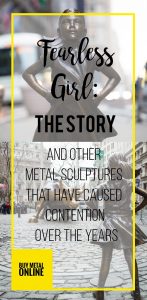New York’s in a frenzy about the Fearless Girl metal sculpture, but it’s not the first time public art has caused a storm. We took a look at some of the sheet metal sculptures that have caused contention over the years.
One of the most famous public art controversies also happened in New York. In 1981, Richard Serra’s Tilted Arc, which was essentially a long, Corten steel panel, was installed in Foley Federal Plaza, and immediately attracted controversy. Concerns raised by the public included suggestions it was a security risk to people complaining that it just looked like a big piece of rusty sheet metal. Eventually, after court battles and arguments galore, Tilted Arc was taken down in 1989.
Art in public places almost always causes a clash of opinions, whether it’s made of stone or sheet metal. Price is one of the main issues: art like this is often funded by councils and government organisations and some people feel that the money could be better spent.
In many cases, it’s simply the look of a sculpture that people object to. In Ilfracombe, Devon, modern artist Damien Hirst’s sculpture Verity, made of bronze and stainless steel sheet metal, prompted complaints and plenty of press attention. Standing at over 20 metres tall, the imposing artwork shows the cross-section of a pregnant woman holding a sword high above her head.
In 2005, Another Place by Antony Gormley, whose most famous work is perhaps the Corten steel Angel of the North, was installed on Crosby Beach on the outskirts of Liverpool. Featuring 100 naked cast-iron sculptures of the artist himself, the piece caused public outcry from people worried about the safety of visitors heading out towards the sea to look at them, as well as the cost to the council. In 2007, though, it was decided that the ‘Iron Men’, as they became known locally, would stay in place permanently and they now attract tourists from far and wide.
Not all public art controversies end so positively though. The B of the Bang, by Thomas Heatherwick, was commissioned to mark the Commonwealth Games in Manchester in 2002. The huge sculpture, made of Corten steel, cost £1.42 million to be constructed and installed, but started having structural problems soon afterwards. When spikes of sheet steel began to fall off the artwork, it was dismantled and taken into storage and eventually, parts of the sheet metal used to construct it were sold for scrap.
One thing’s for sure, though, whether they’re made of sheet metal or stone, artworks in the public domain almost always cause debates and conversations.
Back in New York, Arturo Di Modica, whose bronze Charging Bull has been on display in the centre of the financial district since 1989, says that the addition of the Fearless Girl in front of his work infringes his copyright by altering the dynamic of the original sculpture. The metal sculpture by Kristen Visbal was installed just in time for International Women’s Day and features a little girl standing bravely with her hands on her hips in front of the bull. It is said that the sculpture sends a message about the lack of women on boards in the New York financial industry, and people have been flocking to photograph it. For now, she looks set to remain, with the Mayor of New York saying Fearless Girl can stay right where she is, proud and steadfast, until February 2018.

Fearless Girl by Kristen Visbal, photographed by Anthony Quintano and shared under a Creative Commons Licence 2.0


